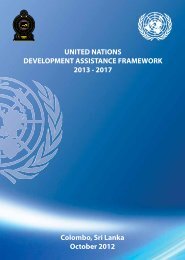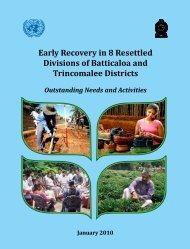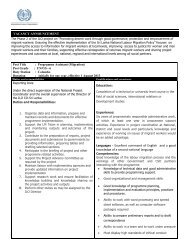Sri Lanka Human Development Report 2012.pdf
Sri Lanka Human Development Report 2012.pdf
Sri Lanka Human Development Report 2012.pdf
Create successful ePaper yourself
Turn your PDF publications into a flip-book with our unique Google optimized e-Paper software.
Figure 4.10: Distribution of University Enrolments by Subject<br />
Source: Ministry of Education of Singapore 2010. Source: University Grants Commission of <strong>Sri</strong> <strong>Lanka</strong> 2012a.<br />
Source: University Grants Commission of India.<br />
A challenge facing the university system is its ‘closed’<br />
nature. While there is no explicit legal barrier, in practice,<br />
it is extremely difficult to invest in private universities. 178<br />
Consequently, students who cannot enter public<br />
universities have few other options for higher education.<br />
In 2009, for example, more than 100,000 students, around<br />
83 percent of those who qualified for university education,<br />
were forced to abandon their ambitions to study because<br />
state-funded universities could not accommodate them. 179<br />
Those from highly affluent families opted to go to school<br />
outside <strong>Sri</strong> <strong>Lanka</strong>.<br />
Others, unwilling to sacrifice their desire for higher<br />
education and willing to pay for it, enrolled in one of<br />
around 30 degree-awarding institutions 180 affiliated with<br />
private universities outside <strong>Sri</strong> <strong>Lanka</strong>. These have gained<br />
public attention due to their high cost and questionable<br />
quality. The absence of an accreditation system for them<br />
makes it difficult to regulate their quality, and there are<br />
no proper quality assurance, control and monitoring<br />
mechanisms.<br />
As noted earlier, the government policy document<br />
‘Mahainda Chinthana—Vision for the Future’ aims<br />
for a dynamic and modernized education system. It<br />
would help to create a knowledge-based economy by<br />
providing competencies and specialized technical skills<br />
for rapid growth and a competitive position in the<br />
global economy. Key policy priorities include: successful<br />
completion of primary and secondary education by all<br />
students; educational services designed around the needs<br />
of all children; improvements in the quality of general<br />
education and its relevance to the demands of the labour<br />
market; and the equipping of children with English and<br />
Mathematics competencies. 181 The Ministry of Education<br />
has developed a complementary policy document, ‘New<br />
Vision for Education, 2010’, that further emphasizes the<br />
need to modernize the education system. 182<br />
In particular, the Ministry aims to enhance competencies<br />
in Science, Mathematics, English and Information<br />
Technology. Measures are already in place to move<br />
towards a competency-based curriculum and away from an<br />
76<br />
sri lanka <strong>Human</strong> <strong>Development</strong> report 2012






